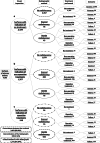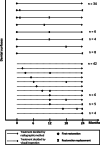Negligible therapeutic impact, false-positives, overdiagnosis and lead-time are the reasons why radiographs bring more harm than benefits in the caries diagnosis of preschool children
- PMID: 33789655
- PMCID: PMC8011211
- DOI: 10.1186/s12903-021-01528-w
Negligible therapeutic impact, false-positives, overdiagnosis and lead-time are the reasons why radiographs bring more harm than benefits in the caries diagnosis of preschool children
Abstract
Background: To evaluate the clinical course and interventions required during two years of follow-up of dental surfaces of deciduous molars diagnosed, and consequently treated, by two different strategies: diagnosis made by clinical examination alone or associated with radiographs.
Methods: This is a secondary analysis of a two-arm randomized clinical trial with parallel groups related to the diagnostic strategy for caries detection in preschool children. 216 children (3-6 years old) were followed-up for two years. All dental surfaces were diagnosed by visual inspection and later, through radiographic assessment. Baseline treatment was made in accordance with the results obtained by visual inspection performed alone or combined with radiographic method, considering the allocated group. Dental surfaces with no restoration needs, or those restored at the beginning of the study were followed-up for two years. The treatment decision was made according to the allocated group. The outcome was the occurrence of failure (a new caries lesion or a restoration replacement) during the follow-up.
Results: 4383 proximal and occlusal surfaces of deciduous molars in 216 preschool children were diagnosed and treated according to the abovementioned diagnostic strategies and followed-up for 24 months. The assessment of radiographs made change the initial decision reached by visual inspection in about 30% of the surfaces when all types of interventions were considered. However, most disagreements occurred for initial lesions, where radiographs tended to underestimate them. Discordances between methods occurred in less than 5% of all surfaces when considered lesions requiring operative treatment. For discrepancy cases, the placed interventions guided by following the radiographic results did not present less failures against those made following only visual inspection. As a matter of fact, the use of radiographs in the diagnostic strategy for caries detection in children brought more harms than benefits due to the occurrence of false-positives, overdiagnosis and lead-time bias.
Conclusions: Simultaneous association of visual inspection and radiographic assessment for caries detection in preschool children causes more harms than benefits, and therefore, visual inspection should be conducted alone in the regular clinical practice. Trial registration Clinicaltrials.gov platform: NCT02078453, registered on 5th March 2014.
Keywords: Children; Clinical trial; Dental caries; Diagnosis; Primary teeth; Radiography.
Conflict of interest statement
All authors declare: no support from any organization for the submitted work other than those listed above; no financial relationships with any organizations that might have an interest in the submitted work; no other relationships or activities that could appear to have influenced the submitted work. Mariana M. Braga is Senior Editorial Board Member of the BMC Oral Health. Moreover, Thais Gimenez and Daniela P. Raggio are Associate Editors in the same journal.
Figures








References
-
- Welch HG, Schwartz LM, Woloshin S. Overdiagnosed: making people sick in the pursuit of health. Boston: Beacon Press; 2011.
Publication types
MeSH terms
Associated data
LinkOut - more resources
Full Text Sources
Other Literature Sources
Medical
Research Materials

